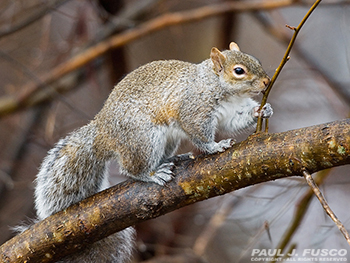Squirrel Nuisance Problems
Management of Problem Gray Squirrels
Most complaints about gray squirrels are from homeowners with squirrels in their houses. Squirrels will readily take up residence in a building if access to sheltered areas such as eaves and attic crawl spaces is available. Gnawing, scratching, and pattering sounds, in early morning or daylight hours, usually signal their presence. Balls of torn insulation, cardboard, and dried leaves and twigs may pinpoint nests, but nests and young may be totally concealed within eaves or wall spaces. Squirrels in house eaves and attics can damage insulation and electrical wiring and should be removed.
When blocking holes to prevent squirrels and other animals from gaining access, be sure that none are trapped inside. Adults can cause severe damage by chewing to regain entrance to reach their young. If chewing persists, heavy, half-inch wire mesh can be temporarily placed over the problem area. Trimming shrubs and vines and pruning overhanging tree limbs may discourage squirrels from causing problems in the home. Bright lights or noise from radios may also help.
Gray squirrels are highly excitable and can cause severe damage if trapped inside a building. When frightened, they tend to run around a room with reckless abandon, knocking over anything in their way. By quickly and quietly opening a door or window to the outside and leaving the room, you will give the squirrel its best chance to get out.
To free a squirrel trapped in a chimney, lower a heavy rope down the chimney to provide a means for the animal to climb out. Drop the other end of the rope to the ground to avoid another trip to the roof to retrieve it after the squirrel has left.
Another major complaint about squirrels is the disruption they may cause at bird feeders. Feeders should be placed in an area where squirrels cannot gain access to them, far away from shrubs and overhanging tree branches. Mounting the feeder on a metal pole at least six feet high and attaching a metal, cone-shaped baffle to the pole will help prevent squirrels from reaching it. Hanging feeders are not recommended because squirrels will climb down the hanger wire or will shake the wire until the food falls to the ground. Several squirrel-proof bird feeders are available at hardware and bird specialty stores.
Live-trapping gray squirrels, using metal box traps at least two feet long is often the most effective way to remove them. Place traps, baited with apple chunks, peanut butter, or various nuts, in heavily traveled routes or on rooftops, along porch railings, or within the attic. Once trapped, squirrels should be quickly removed from cages and released.
Management of Problem Flying Squirrels
Most complaints about flying squirrels are from homeowners with squirrels in their houses. Squirrels will readily take up residence in a building if access is available to a sheltered area. Flying squirrels enter homes through small holes around dormers, ridge vents, eaves, attic vents, and similar vulnerable areas. All such holes should be closed to prevent squirrels and other animals from gaining entrance. Be sure that no squirrels are trapped inside. Adults can cause severe damage by chewing to regain entrance to reach their young. If chewing persists, heavy, half-inch wire mesh can be temporarily placed over the problem area. Trimming shrubs and vines and pruning overhanging tree limbs may discourage squirrels from causing problems in the home.
A squirrel trapped in a chimney should not be removed through the fireplace area because it might escape into the room. Instead, lower a heavy rope down the chimney to provide the means for the animal to climb out. Drop the other end of the rope to the ground to avoid another trip to the roof to retrieve it after the squirrel has left.
The trapping of squirrels can temporarily solve a persistent problem but will not help in the long run because other squirrels will soon come into an area to replace the removed animals.
For more information on the management of problem squirrels or for a referral to a licensed Nuisance Wildlife Control Operator, contact the Wildlife Division at deep.wildlife@ct.gov or 860-424-3011.
Do you need additional help and advice concerning nuisance wildlife? Check out www.wildlifehelp.org and select "Connecticut" as your state to get started. WildlifeHelp.org is supported by the Northeast Association of Fish and Wildlife Agencies and the Northeast Wildlife Damage Management Cooperative.
Content last updated on April 1, 2020.


